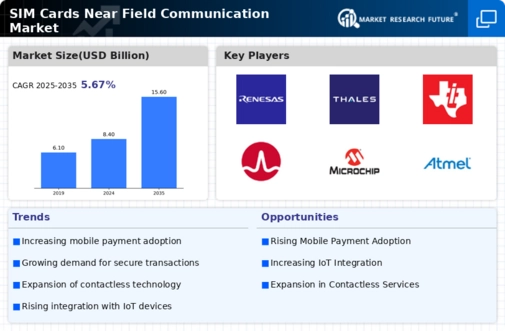Market Growth Projections
The Global SIM Cards Near Field Communication Market Industry is poised for substantial growth, with projections indicating a market size of 8.4 USD Billion in 2024 and an anticipated increase to 15.6 USD Billion by 2035. This growth trajectory suggests a compound annual growth rate (CAGR) of 5.78% from 2025 to 2035, highlighting the increasing demand for NFC technology across various sectors. The expansion of mobile payment solutions, IoT applications, and enhanced security features are key factors contributing to this upward trend. As the market evolves, stakeholders are likely to explore innovative applications of NFC technology to capitalize on emerging opportunities.
Enhanced Security Features
The demand for enhanced security features in mobile communications is driving growth in the Global SIM Cards Near Field Communication Market Industry. As cyber threats become more sophisticated, consumers and businesses alike seek solutions that offer robust protection for their transactions and data. NFC technology, when integrated with secure SIM cards, provides an additional layer of security through encryption and authentication processes. This focus on security is likely to attract more users to NFC-enabled SIM cards, thereby expanding the market. The anticipated CAGR of 5.78% from 2025 to 2035 suggests a sustained interest in secure communication solutions.
Expansion of IoT Applications
The proliferation of Internet of Things (IoT) applications significantly influences the Global SIM Cards Near Field Communication Market Industry. As IoT devices become more prevalent across various sectors, including healthcare, automotive, and smart cities, the need for efficient communication methods intensifies. NFC-enabled SIM cards facilitate seamless connectivity between devices, enabling real-time data exchange. This trend is expected to contribute to the market's growth, with projections indicating a rise to 15.6 USD Billion by 2035. The integration of NFC technology in IoT devices not only enhances functionality but also supports the development of innovative solutions that cater to evolving consumer needs.
Rising Smartphone Penetration
The continuous rise in smartphone penetration globally serves as a significant catalyst for the Global SIM Cards Near Field Communication Market Industry. With an increasing number of consumers adopting smartphones equipped with NFC capabilities, the demand for compatible SIM cards is likely to surge. In 2024, the market is expected to reach 8.4 USD Billion, driven by the growing reliance on mobile devices for various applications, including payments, ticketing, and access control. As smartphone manufacturers increasingly incorporate NFC technology into their devices, the market for SIM cards that support these features is poised for substantial growth.
Government Initiatives and Regulations
Government initiatives and regulations promoting digital transactions and contactless payments are pivotal in shaping the Global SIM Cards Near Field Communication Market Industry. Many countries are implementing policies that encourage the adoption of NFC technology to enhance financial inclusion and streamline payment processes. These initiatives not only foster a conducive environment for the growth of NFC-enabled SIM cards but also stimulate consumer confidence in digital transactions. As a result, the market is projected to expand significantly, with estimates indicating a potential growth to 15.6 USD Billion by 2035, reflecting the positive impact of regulatory support on the industry.
Growing Adoption of Mobile Payment Solutions
The increasing acceptance of mobile payment solutions is a primary driver for the Global SIM Cards Near Field Communication Market Industry. As consumers increasingly prefer contactless transactions, the demand for SIM cards equipped with NFC technology rises. In 2024, the market is projected to reach 8.4 USD Billion, reflecting a growing trend towards digital wallets and mobile banking. Major players in the financial sector are integrating NFC capabilities into their services, which further propels the adoption of SIM cards with NFC features. This shift not only enhances user convenience but also aligns with global efforts to promote cashless economies.























Leave a Comment